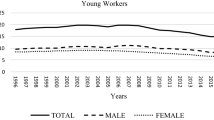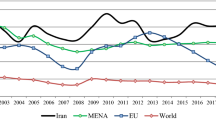Abstract
North African countries recorded the highest youth unemployment rate in the World during the latest years. The main causes for that situation continue to be at the forefront of the debate among economists, sociologists and policymakers. This paper contributes to the existing literature by estimating the Okun’s law for four North African economies over the period 1991–2013. It examines the reaction of unemployment rate to output for different groups of the labor force as determined by age-group and gender. In addition to the basic linear specification, we present estimates of the Okun’s coefficients by taking into account the potential presence of structural breaks, threshold and asymmetry. The empirical investigation highlights the presence of mixed findings regarding the significance, magnitude and stability of coefficients for the different groups of the labor force and countries. Policy implications are correspondingly drawn.

Source: The authors, based on data from the ILOSTAT database

Source: The authors, based on data from the Key Indicators of the Labour Market database

Source: The authors, based on data from the Key Indicators of the Labour Market database

Source: The authors, based on data from the Key Indicators of the Labour Market database

Source: The authors, based on data from the Doing Business database
Similar content being viewed by others
Notes
The author employs four filtering methods, namely the quadratic trend, the Hodrick–Prescott, the Band-Pass and the structural time series model.
The three components are: consumption growth, investment growth and export growth.
The index ranges from 0 to 100, where higher values indicate more rigid regulations.
Informal employment includes self-employment in informal enterprises, generally small and not registered, and paid employment that is not formally declared, without legal contracts or social protections (Danish Trade Union Council for International Development and Cooperation 2018).
References
Achy, L. 2010. Trading high unemployment for bad jobs: Employment challenges in the Maghreb. Carnegie papers no. 23. Washington, DC: Carnegie Endowment for International Peace.
Adanu, K. 2005. A cross-province comparison of Okun’s coefficient for Canada. Applied Economics 37: 561–570.
Aita, S. 2008. Employment and labor law in the Arab Mediterranean countries and the Euromediterranean Partnership. Madrid: Fundación Paz y Solidaridad Serafín and Agencia Española de Cooperación Internacional.
Angel-Urdinola, D.F., and A. Kuddo. 2010. Key characteristics of employment regulations in the Middle East and North Africa. SP discussion paper no. 1006. Washington, DC: World Bank.
Angel-Urdinola, D.F., A. Kuddo, and A. Semlali. 2013. Building effective employment programs for unemployed youth in the Middle East and North Africa., Directions in development: Human development Washington, DC: World Bank.
Angel-Urdinola, D.F., A. Nucifora, and D. Robalino. 2015. Labor policy to promote good jobs in Tunisia: Revisiting labor regulation, social security, and active labor market programs., Directions in development: Human development Washington, DC: World Bank.
Auer, P., Ü. Efendioglu, and J. Leschke. 2008. Active labour market policies around the world: Coping with the consequences of globalization, 2nd ed. Geneva: International Labour Organization.
Bai, J., and P. Perron. 1998. Estimating and testing linear models with multiple structural changes. Econometrica 66: 47–78.
Bai, J., and P. Perron. 2003. Computation and analysis of multiple structural change models. Journal of Applied Econometrics 18: 1–22.
Banerji, A., H.H. Lin, and S. Saksonovs. 2015. Youth unemployment in advanced Europe: Okun’s law and beyond. Working paper no. 15/5. Washington, DC: International Monetary Fund.
Barsoum, G., S. Wahby, and A. Sarkar. 2017. Youth and employment in North Africa: A regional overview. Geneva: International Labour Organization.
Ben-Salha, O. 2013. Labour market outcomes of economic globalisation in Tunisia: A preliminary assessment. The Journal of North African Studies 18: 349–372.
Betcherman, G. 2014. Designing labor market regulations in developing countries. IZA World of Labor. https://doi.org/10.15185/izawol.57.
Binet, M., and F. Facchini. 2013. Okun’s law in the French regions: A cross-regional comparison. Economics Bulletin 33: 420–433.
Boďa, M., and M. Považanová. 2015. Gender asymmetry in Okun’s law in the four PIGS countries. Procedia Economics and Finance 30: 111–123.
Cevik, E.I., S. Dibooglu, and S. Barişik. 2013. Asymmetry in the unemployment–output relationship over the business cycle: Evidence from transition economies. Comparative Economic Studies 55: 557–581.
Chinn, M., L. Ferrara, and V. Mignon. 2014. Explaining US employment growth after the great recession: The role of output–employment non-linearities. Journal of Macroeconomics 42: 118–129.
Christopoulos, D.K. 2004. The relationship between output and unemployment: Evidence from Greek regions. Papers in Regional Science 83: 611–620.
Cuaresma, J.C. 2003. Okun’s law revisited. Oxford Bulletin of Economics and Statistics 65: 439–451.
Danish Trade Union Council for International Development and Cooperation. 2018. Labour market profile: Morocco. Copenhagen: Danish Trade Union Council for International Development and Cooperation.
Dixon, R.J., G.C. Lim, and J.V. Ours. 2016. Revisiting Okun’s relationship. IZA discussion paper no. 9815. Bonn: The Institute for the Study of Labor.
Durech, R., A. Minea, L. Mustea, and L. Slusna. 2014. Regional evidence on Okun’s law in Czech Republic and Slovakia. Economic Modelling 42: 57–65.
Dyer, P. 2005. Disponibilité de main-d’oeuvre, chômage et création d’emplois dans le Maghreb. Report presented at the meeting on ‘Genre et développement’, Tunis, 24–25 May.
Economou, A., and I.N. Psarianos. 2016. Revisiting Okun’s law in European Union countries. Journal of Economic Studies 43: 275–287.
Fouquau, J. 2008. Threshold effects in Okun’s law: A panel data analysis. Economics Bulletin 5: 1–14.
Freeman, D.G. 2000. Regional tests of Okun’s law. International Advances in Economic Research 6: 557–570.
Gabrisch, H., and H. Buscher. 2006. The relationship between unemployment and output in post-communist countries. Post-communist Economies 18: 261–276.
Gatti, R., D.F. Angel-Urdinola, J. Silva, and A. Bodor. 2014. Striving for better jobs: The challenge of informality in the Middle East and North Africa., Directions in development: Human development Washington, DC: World Bank.
Haouas, I., E. Sayre, and M. Yagoubi. 2012. Youth unemployment in Tunisia: Characteristics and policy responses. Topics in Middle Eastern and African Economies 14: 395–415.
Harris, R., and B. Silverstone. 2001. Testing for asymmetry in Okun’s law: A cross-country comparison. Economics Bulletin 5: 1–13.
Herzog, R.W. 2013. Using state level employment thresholds to explain Okun’s law. IZA Journal of Labor Policy 2: 1–26.
Hodrick, R.J., and E.C. Prescott. 1997. Post-war US business cycle: An empirical investigation. Journal of Money, Credit, and Banking 29: 1–16.
Huang, H.C. 2003. Okun’s law revisited: a structural change approach. Working paper, Tamkang University.
Huang, H.C., and Y.K. Chang. 2005. Investigating Okun’s law by the structural break with threshold approach: Evidence from Canada. The Manchester School 73: 599–611.
Hutengs, O., and G. Stadtmann. 2013. Age effects in Okun’s law within the Eurozone. Applied Economics Letters 20: 821–825.
Hutengs, O., and G. Stadtmann. 2014. Don’t trust anybody over 30: Youth unemployment and Okun’s law in CEE countries. Bank i Kredyt 45: 1–16.
International Labour Organization. 2002. Women and men in the informal economy: A statistical picture, 1st ed. Geneva: International Labour Organization.
International Labour Organization. 2013. Global employment trends 2013: Recovering from a second jobs dip. Geneva: International Labour Organization.
International Labour Organization. 2015. Global employment trends for youth 2015: Scaling up investments in decent jobs for youth. Geneva: International Labour Organization.
International Labour Organization. 2018. World employment and social outlook—Trends 2018. Geneva: International Labour Organization.
Jardin, M., and G. Stephan. 2012. How Okun’s law is non-linear in Europe: A semi-parametric approach. Paper presented at the 16th annual conference on macroeconomic analysis and international finance, Crete.
Kitov, I., and O. Kitov. 2012. Modeling unemployment and employment in advanced economies: Okun’s law with a structural break. Theoretical and Practical Research in Economic Fields 3: 26–41.
Knotek, E.S. 2007. How useful is Okun’s law? Economic Review, Federal Reserve Bank of Kansas City, Fourth Quarter 94: 73–103.
Koutroulis, A., Y. Panagopoulos, and E. Tsouma. 2016. Asymmetry in the response of unemployment to output changes in Greece: Evidence from hidden co-integration. The Journal of Economic Asymmetries 13: 81–88.
Lee, J. 2000. The robustness of Okun’s law: Evidence from OECD countries. Journal of Macroeconomics 22: 331–356.
Malley, J., and H. Molana. 2008. Output, unemployment and Okun’s law: Some evidence from the G7. Economics Letters 101: 113–115.
Marconi, G., M. Beblavý, and I. Maselli. 2016. Age effects in Okun’s law with different indicators of unemployment. Applied Economics Letters 23: 580–583.
Marinkov, M., and J.P. Geldenhuys. 2007. Cyclical unemployment and cyclical output: An estimation of Okun’s coefficient for South Africa. South African Journal of Economics 75: 373–390.
Melguizo, C. 2017. An analysis of the Okun’s law for the Spanish provinces. Review of Regional Research 37: 59–90.
Millennium Development Goal Fund. 2009. Engaging Tunisian youth to achieve the MDGs. Tunis: Millennium Development Goal Fund.
Moosa, I.A. 1997. A cross-country comparison of Okun’s coefficient. Journal of Comparative Economics 24: 335–356.
Musette, M.S. 2014. Employment policies and active labour market programmes in Algeria. Turin: European Training Foundation.
Okun, A.M. 1962. Potential GNP: Its measurement and significance. In Proceedings of the business and economic statistics section. American Statistical Association.
Palombi, S., R. Perman, and C. Tavera. 2017. Commuting effects in Okun’s law among British areas: Evidence from spatial panel econometrics. Papers in Regional Science 96: 191–209.
Pereira, R.M. 2014. Okun’s law, asymmetries and regional spillovers: Evidence from Virginia metropolitan statistical areas and the District of Columbia. The Annals of Regional Science 52: 583–595.
Razzu, G., and C. Singleton. 2013. Are business cycles gender neutral? Economics and management discussion paper no. 2013-104. Henley Business School.
Redjeb, M.S., and M. Ghobentini. 2005. L’intermédiation sur le marché du travail en Tunisie. Employment strategy paper no. 19. Geneva: International Labour Organization.
Shin, Y., Y. Byungchul, and M. Greenwood-Nimmo. 2014. Modelling asymmetric cointegration and dynamic multipliers in a nonlinear ARDL framework. In Festschrift in honor of Peter Schmidt, ed. R.C. Sickles and W.C. Horrace. New York: Springer.
Silvapulle, P., I.A. Moosa, and M.J. Silvapulle. 2004. Asymmetry in Okun’s law. The Canadian Journal of Economics 37: 353–374.
Sögner, L. 2001. Okun’s law: Does the Austrian unemployment-GDP relationship exhibits structural breaks? Empirical Economics 26: 553–564.
Sögner, L., and A. Stiassny. 2002. An analysis on the structural stability of Okun’s law—A cross-country study. Applied Economics 34: 1775–1787.
Subrahmanyam, G. 2011. Tackling youth unemployment in the Maghreb. AFDB economic brief. Abidjan: African Development Bank Group.
Subrahmanyam, G., and V. Castel. 2014. Labour market reforms in post-transition North Africa. AFDB economic brief. Abidjan: African Development Bank Group.
Villaverde, J., and A. Maza. 2009. The robustness of Okun’s law in Spain, 1980–2004: Regional evidence. Journal of Policy Modeling 31: 289–297.
Wahba, J., and R. Assaad. 2017. Flexible labor regulations and informality in Egypt. Review of Development Economics 21: 962–984.
WEF and OECD. 2011. Arab world competitiveness report 2011–2012. Geneva: World Economic Forum.
World Bank. 2004. Republic of Tunisia: Employment strategy, vol. 1. Main report. Washington, DC: World Bank.
World Bank. 2011. Policies to reduce informal employment: An international survey. Washington, DC: World Bank.
World Bank. 2013. Jobs for shared prosperity: Time for action in the Middle East and North Africa. Washington, DC: World Bank.
World Bank. 2017. Doing business database. Washington, DC: World Bank. http://www.doingbusiness.org/content/dam/doingBusiness/media/Annual-Reports/English/DB17-Report.pdf.
Zanin, L. 2014. On Okun’s law in OECD countries: An analysis by age cohorts. Economics Letters 125: 243–248.
Zouari, S. 2014. Employment policies and active labour market programmes in Tunisia. Turin: European Training Foundation.
Acknowledgements
The authors are grateful to the editor of the journal, Nauro Campos, and an anonymous referee for invaluable comments and suggestions that substantially improved the manuscript’s content. Any remaining errors are solely the authors’ responsibility.
Author information
Authors and Affiliations
Corresponding author
Additional information
Publisher's Note
Springer Nature remains neutral with regard to jurisdictional claims in published maps and institutional affiliations.
Rights and permissions
About this article
Cite this article
Ben-Salha, O., Mrabet, Z. Is Economic Growth Really Jobless? Empirical Evidence from North Africa. Comp Econ Stud 61, 598–624 (2019). https://doi.org/10.1057/s41294-018-00082-9
Published:
Issue Date:
DOI: https://doi.org/10.1057/s41294-018-00082-9





